Giant Cell Tumor
It all began with an achy left knee. It ached for years, really. Then, summer before last, I took a healthy spill while mountain biking and hit it but good on some partially buried lava rocks. After that it really was never the same, and I assumed that I’d done some sort of ligament damage to it.
By November of 2017 it was troublesome enough to keep me from playing soccer with my son. Kicking the ball, especially on the inside of my foot, would set off an advanced ache that would last for days. It was at this point that my wife insisted I have it looked at. I told the ortho that I was sure I’d damaged some ligaments. An x-ray was performed. Much to my surprise my ligaments looked fine. What was concerning was a definite large lump of bone in the top of my tibia. The doctor said it could be a tumor. An MRI was performed. My wife said those damned doctors always go for the worst case scenario, so surely it wasn’t a tumor.
The following week the doctor was running late for my return appointment to discuss the MRI. Very late. Rather than reschedule me, they shuffled me into an examination room to wait in private. About a half hour later, when the doctor still hadn’t arrived and the nurses were continuing to check in on me and assure me I should wait, I knew it had to be a tumor. They wouldn’t keep me for anything they weren’t concerned about.
When the doc finally swept in the room I said, in my most Ahnuld accent, “It’s a toomah!” He didn’t crack a smile. Instead, he rolled the computer monitor my way and presented this:
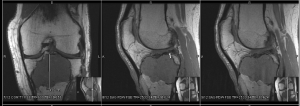
It was a tumor – a big one. It had all the characteristics of a Giant Cell Tumor, he said, and those are usually benign. Still, there were two problems: benign or not, it was eating away at the top of my tibia, and there is no one where I live in Bend, Oregon with the qualifications to treat it. He sent my images and story off to some doctors in Portland and sent me on my way with a CD of my x-rays and MRI images. I drove home, shell shocked.
Once home, the research began. Turns out there aren’t many orthopedic surgeons in the United States with experience in handling these tumors, and even fewer experts. We found an older fellow who was a pioneer in the field. It said he was in Seattle, but we discovered he’d relocated to somewhere in Texas. We found a few others as well, and called the ortho office to send my information to them all.
Then we found an expert at UF in Florida.
We have a cousin who is also a doctor currently working a residency at UF as well. We called him, he called this orthopedic surgeon, and not an hour later the surgeon called me directly. By the end of the day it was determined. We would fly to Florida by week’s end. The following week I’d have a biopsy which would be immediately examined and – if it was indeed a giant cell tumor – they’d commence with excising it, which would involve drilling a quarter sized hole in my tibia, scraping out the tumor, hitting the interior with an argon laser to burn any residual tissue, filling the cavity with cadaver bone and bone cement, and screwing a plate over the hole and down the bone for added strength. They also told me to get on crutches immediately, as the tumors edges were so close to the margins of my bone that my mere body weight could shatter it. This was extremely disconcerting, as the day prior I’d been out with my family rolling and pushing giant snowballs.
People thought we were crazy, flying from Oregon to Florida. We figured since we had no choice but to travel somewhere, Florida made as much sense as anywhere. More, really. This orthopedic surgeon was an expert in this and, thanks to our cousin, had taken a personal interest in my case. And that same cousin generously offered up their place to stay. And where would you rather recover from surgery – somewhere cold, dark and snowy, or somewhere warm, sandy and sunny with an ocean view?
At our pre-op appointment we got down to the nitty gritty. It was explained to us that if it wasn’t actually a giant cell tumor, but rather something more nefarious, standard operating procedure was to resect the top of my tibia altogether, replacing it with metal and pulling muscles from my calf up and around to try to strengthen it all. This was a much more serious surgery with harsher implications. It could change my ability to walk for the rest of my life.
We decided to tell them that if it came back as something other than GCT, we wanted them to stop so we could have it thoroughly stained and tested and make absolutely sure what it was and what our next steps would be. They agreed.
I knew as soon as I woke up that things weren’t right. Somehow, I just knew.
They’d put me under, run a nerve block into my leg, drilled a hole into my tibia, pulled out a sample, and left me under while it was tested. Some of it – quite a bit of it – looked like classic GCT. But some of it didn’t. Worse, that which didn’t look like GCT also didn’t really match anything else either. So they filled the hole with cement, stitched me up, and woke me up. They told me that they would have stopped right there even if we hadn’t had the previous discussion about doing so, because they just weren’t sure what it was they were looking at.
My leg was wrapped tight. Because the nerve block effectively deadened the entire leg, it was encased in a splint to prevent movement. Without it I could easily do myself harm and not know it until the block wore off. I was sent home – home being our cousins house – armed with my crutches and wheelchair and a fistfull of pain medications I thought were surely overkill until that night when the nerve block abruptly wore off.
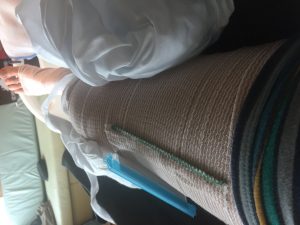
What had started as an almost-certainly-benign tumor suddenly entered the odds of 50/50 at best. It was sent off to others for examination as well, including a cancer facility in Orlando and Sloan Kettering in New York. I slowly began healing from the biopsy, which proved more painful than I expected, and we wondered how long long we’d be in Florida. I couldn’t sleep much, both because of my leg and the specter of cancer.
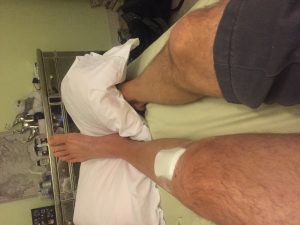
Two anxiety ridden weeks went by as test after test returned inconclusive. Eventually it came down to waiting one last test, a newer one. The tests for the nastiest sarcomas had returned negative, and the one we were waiting on would only show whether or not it was GCT. It was decided that we should go ahead with the original excision procedure, and they’d take every precaution to isolate the tumors contents as to not allow any spread. We didn’t know for sure what it was, but we knew what it wasn’t.
They put two nerve blocks in for this procedure as well as knocking me on my can with a general. The procedure took about 3 or so hours.
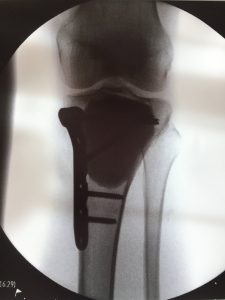
This time they left the nerve blocks in, on trickle, while I was kept in hospital for a few days. I was also on intravenous pain medication as well as antibiotics. The hospital stay was as variable as could be expected. On the second day the meds in my blocks ran out. The nurse on duty – who we hadn’t been impressed with from the jump – took forever to replace them, and in the meantime they’d begun to wear off. I spent a fair few hours a quivering, shivering, sweaty, green nauseous mess until my wife – who was the best advocate one could ask for (and I’ll expound on the necessity of medical advocates later) – muscled her way through the bureaucracy and indifference to force the anesthesiologist to give me a bolus to get me over the hump until the trickle worked its magic.

In a few days the blocks were shut off and I went home – the cousins home – to continue to heal, armed with even more pain meds, including oxycodone, celebrex and tramadol. We still didn’t know the results of the last test, and in the meantime the entirety of the tumor had been sent off for its own analysis. My leg had been swollen and painful after the biopsy. Now it was huge and tremendously painful.
The first week was garbage. I spent all of my time in bed, only getting up when absolutely necessary. I could only lay on my back. The pain meds had me stupid and slow and without appetite altogether. I needed help with almost everything, which drove me crazy.
The second week was slightly less garbage. I weaned myself off of the oxy’s because I hate the way they make me feel. I could get around a little more, but not without considerable pain. Really, it hurt all the time, 24/7. We had determined, however, that we needed to get home. We’d been gone a month and even with the generosity of family the costs were seriously stacking up (not to mention the looming 8 grand deductible my bullshit insurance carries.
But I still had a post op follow up to attend before leaving. Luckily the surgeon worked out of Orlando on Fridays, and the Orlando airport had our cheapest fares home. We booked a morning appointment and a late afternoon flight, determined to get home. Staying in the St Petersburg area, we woke early to drive to Orlando. Riding in the car was difficult, as my leg was determined to stay straight and refused to bear any weight without considerable pain.
The appointment went well. The final test had returned saying it was most likely GCT despite the weird tissue mixed in with it. It was explained that I would have a post op x-ray in about 2 months, and then another x-ray of my knee along with my lungs (GCT, when it travels, tends to wind up in the lungs) every 4 months for the next 2 years. Then it would be twice a year for the next 3 years. The plate could probably be removed, eventually, if it irritated me – which was a possibility. Physical therapy was an obvious given, and I couldn’t engage in any sort of serious impact like running or mountain biking for at least 6 months.
Everyone on the orthopedic surgery team came to see me, and I thanked them all. They wished me luck on our return trip home, clearly knowing more about what lie ahead for me than I did.
We had time to kill between the appointment and our flight, so we ventured into Orlando. I tried to crutch around Lake Eola Park, but it wasn’t long before I needed to be rescued via car. We went to our favorite restaurant in Orlando, Market on South, but I could not bring myself to eat. Eventually some pain meds kicked in and we grabbed some falafel wraps on the way to the airport.
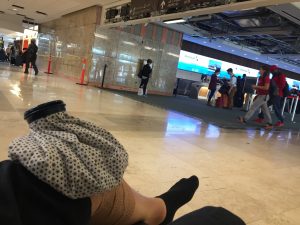
The Orlando airport was a complete shit show. Being in a wheelchair and completely unable to walk without crutches, I was taken through the normal line for a pat down and wanding. The new plate in my leg set off the wand. I explained the situation to the TSA agent, but he clearly didn’t know what to do. He called his supervisor, who was an unpleasant, stern faced woman who refused to look me in the eye or respond to anything I said. She in turn radioed for a male supervisor. This agent was thankfully much more pleasant than she, but also clueless. He gave me a second pat down and then asked me if he could squeeze my knee. I told him he most definitely could not. More confusion ensued as they clearly didn’t know what to do. I finally asked if they’d be satisfied with me unwrapping it to show the incision to them. They agreed, I did, and I was finally sent on my way.
By the time we got to our gate our flight was boarding.
I had a bulkhead seat which I’d paid an extra $100 for, but still I was cramped and uncomfortable for the flight. We landed in Phoenix where we would change planes and grab our son, who had been staying with his grandparents while we were in Florida. Our trip between gates was a rush. At one point a kind stranger, seeing me struggle to climb an incline, pushed me in my wheelchair until we were on flat ground again.
The second plane was significantly smaller than the first, but the bulkhead seat somehow had more legroom. The flight, however, was very cold, and I’d run out of steam before every boarding the plane. Upon landing we discovered that the airline had sent my wheelchair through to the baggage claim despite us having checked it at the gate, so I had to crutch down the ramp, across the tarmac (in Redmond, Oregon you’re deplaning outside, regardless of the size of your aircraft) and through the admittedly small airport.
We’d begun our day at 5 AM EST, and finished it well after 1 AM PST. I slept the entire next day, literally, and half of the next.
As of this writing it has been a month since the operation. I’ve begun PT. I’m off of crutches ahead of schedule. My knee’s range of motion is still severely limited, and there’s still swelling and fluid behind the kneecap, but it’s a bit better with every day. Aside from my PT exercises I’m riding my road bike, which I’ve placed on a trainer in my office, for 10-15 minutes multiple times a day.
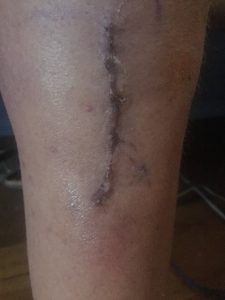
I’m off of all the pain medications as well. Tramadol was the worst. The first night off of it I felt like I had the flu. The next couple of days I was filled with anxiety and unease. I broke out in an extremely itchy rash which seemed randomly dispersed. It manifested on my thighs and back, mostly – nowhere near the incision. I also could not sleep, which I still cannot. I’ve read online that Tramadol withdrawal induced insomnia can last weeks. I now wish I’d never taken the damned drug. Shortly after returning home I fell asleep with that old school ice bag, which you can see in the airport picture above, and managed to burn the front of my leg below the incision but good.
There’s also a large roving dead patch to the outside of and below the incision where on the surface I can’t feel anything. The periphery of that patch is all hyper-sensitive pins and needles, a sensation that is for some reason amplified at night. This just exacerbates the insomnia, as a sheet or comforter feels much like someone rubbing sandpaper against a skinned knee.
I’ve still a long way to go but, despite these complications, I think things are going pretty well. I intend to compose further installments of my Giant Cell Tumor Adventure, including covering the clear and overwhelming need for strong medical advocates when dealing with the healthcare system in the United States, but all of that is for another day.

